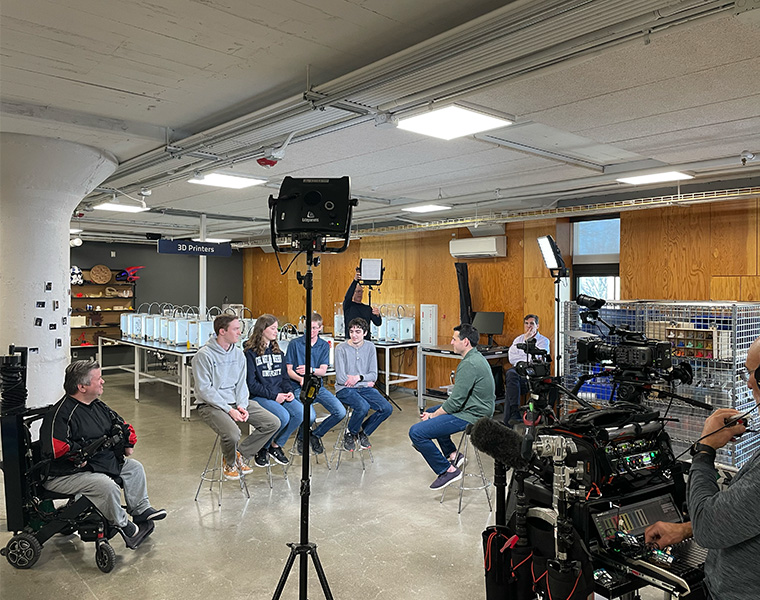A group of Case School of Engineering students recently completed a project that’s helping a local man chase his passion for photography—and their efforts were recognized by NBC Nightly News because of it.
Myles Smith, Amanda Duban, Maxwell Rollins and Grant Boone were among the students who used the resources in the Larry Sears and Sally Zlotnick Sears think[box]—a 50,000-square-foot makerspace at Case Western Reserve University—to craft a device to help photographer Aurelian Barber overcome arthrogryposis. The condition limits the muscles and joints in Barber’s limbs, making it difficult for him to stabilize and position his camera.
After noticing him using think[box] equipment to 3D print items to customize his wheelchair, think[box] staff learned Barber’s end goal was to create an attachment that would help him expand his reach.
Luckily, help was in the building—on the fifth floor, to be exact, which is home to the Humanitarian Design Corps (HDC), a part of Engineers Without Borders.
Under the guidance of makerspace staff, students from the group designed and built an attachment for Barber’s wheelchair: A motorized arm for a swiveling gimbal. The tool allows Barber to take photos at a variety of angles and perspectives—something he’s always dreamed about.
“Even someone with a physical disability can have … artistic ideas, and limitations should not slow them down,” Barber told NBC Nightly News.
The news segment, which closed out the channel’s evening programming on March 28, shows some in-the-field footage of Barber taking photographs near the Cleveland Museum of Art—and follows the students as they demonstrate the tools they used to create the device on floors three, four and five of think[box].
Andrew Rollins, professor of biomedical engineering and medicine and faculty advisor to HDC, said the project was an ideal example of human-centered design.
“Their client, Aurelian, was even a member of the design team, meeting with them weekly,” Rollins said. “This kind of project gives the students the kind of tangible experience they can’t get in class, including dealing with uncertainty and setbacks. It’s also very rewarding for them to help someone in a very direct way.”
Duban, a second-year majoring in biomedical engineering with minors in polymer science and engineering and music, said the opportunity to help Barber take the kind of photos that he envisioned was very meaningful—and she even learned something new along the way.
“My favorite thing about think[box] is how easy it is to learn new skills there,” Duban said. “The student workers are always willing to put in extra effort to help people learn something new or fix problems with a project. Throughout the course of the project, I loved learning how to use the tools in the metal shop.”
Other students on the design team, such as Smith, a fourth-year majoring in mechanical and aerospace engineering and minoring in Chinese, relished the opportunity to use their design and manufacturing skills to help Barber take photos with ease.
“This project was a great opportunity to use my interests to make someone’s life better,” Smith noted.
Learn more about think[box] and watch the NBC Nightly News segment.


